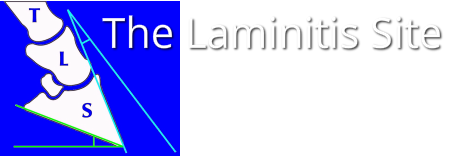It is now recognised that there are distinct 3 forms of laminitis, each with a different cause:
Endocrinopathic Laminitis (EL) including Pasture Associated Laminitis (PAL)
Sepsis Associated Laminitis (SAL)
Supporting Limb Laminitis (SLL)
Endocrinopathic Laminitis (EL) is thought to make up by far the majority (~90%) of laminitis cases. This is laminitis caused by Equine Metabolic Sydrome (EMS) with or without PPID, plus corticosteroid-induced laminitis. Endocrinopathic laminitis includes Pasture Associated Laminitis (PAL), and Pasture and Endocrinopathy-Associated Laminitis may be linked together and called PEAL. This form of laminitis is commonly seen in overweight and probably underworked horses and ponies, that have unrestricted grazing or a high sugar/starch diet.
Sepsis Associated Laminitis (SAL) occurs secondary to a primary illness, such as colitis, acidosis (from starch overload), infection from retained placenta. SAL can be thought of as laminitis in an already very sick horse. SAL is likely to make up less than 10% of laminitis cases, and horses will nearly always have clear indications of infection such as a raised temperature, increased/abnormal white blood cells, and often diarrhoea and/or raised blood lactate.
Supporting limb laminitis (SLL) is rare, and usually seen in horses with a serious lameness such as a fracture or septic joint, and after at least a few days of non-weightbearing on the injured leg - laminitis develops in a supporting leg, often the other front leg if it is a front leg that has the fracture/infection. SLL can be thought of as laminitis in an already very lame horse.
Endocrinopathic Laminitis (EL) including Pasture Associated Laminitis (PAL)
Sepsis Associated Laminitis (SAL)
Supporting Limb Laminitis (SLL)
Endocrinopathic Laminitis (EL) is thought to make up by far the majority (~90%) of laminitis cases. This is laminitis caused by Equine Metabolic Sydrome (EMS) with or without PPID, plus corticosteroid-induced laminitis. Endocrinopathic laminitis includes Pasture Associated Laminitis (PAL), and Pasture and Endocrinopathy-Associated Laminitis may be linked together and called PEAL. This form of laminitis is commonly seen in overweight and probably underworked horses and ponies, that have unrestricted grazing or a high sugar/starch diet.
Sepsis Associated Laminitis (SAL) occurs secondary to a primary illness, such as colitis, acidosis (from starch overload), infection from retained placenta. SAL can be thought of as laminitis in an already very sick horse. SAL is likely to make up less than 10% of laminitis cases, and horses will nearly always have clear indications of infection such as a raised temperature, increased/abnormal white blood cells, and often diarrhoea and/or raised blood lactate.
Supporting limb laminitis (SLL) is rare, and usually seen in horses with a serious lameness such as a fracture or septic joint, and after at least a few days of non-weightbearing on the injured leg - laminitis develops in a supporting leg, often the other front leg if it is a front leg that has the fracture/infection. SLL can be thought of as laminitis in an already very lame horse.
Causes of Endocrinopathic/Pasture Associated Laminitis
Coleman M, Belknap J, Bramlage L, Eades S, Fraley B, Galantino-Homer H, Hunt R, Geor R, McCue M, McIlwraith W, Moore R, Peroni J, Townsend H, White N, Cummings K, Ivanek-Miojevic R, Cohen N
Case Control Study of Pasture and Endocrinopathy-Associated Laminitis in Horses
Equine Endocrinology Summit 2017
"Horses with an obese body condition (BCS ≥ 7), generalized or regional adiposity, a historic diagnosis of an endocrinopathy, and recent glucocorticoid administration were at increased odds of developing PEAL."
Coleman M, Belknap J, Bramlage L, Eades S, Fraley B, Galantino-Homer H, Hunt R, Geor R, McCue M, McIlwraith W, Moore R, Peroni J, Townsend H, White N, Cummings K, Ivanek-Miojevic R, Cohen N
Case Control Study of Pasture and Endocrinopathy-Associated Laminitis in Horses
Equine Endocrinology Summit 2017
"Horses with an obese body condition (BCS ≥ 7), generalized or regional adiposity, a historic diagnosis of an endocrinopathy, and recent glucocorticoid administration were at increased odds of developing PEAL."
Research relating to specific causes:
Am J Vet Res. 1995 Jan;56(1):22-6 (PubMed)
Aggregate risk study of exposure to endophyte-infected (Acremonium coenophialum) tall fescue as a risk factor for laminitis in horses
Rohrbach BW, Green EM, Oliver JW, Schneider JF
"Loline and ergot alkaloids found in endophyte-infected (Acremonium coenophialum) tall fescue (EITF) cause vasoconstriction of equine vessels in vitro."
"Preliminary data support an association between horses exposed to EITF and increased risk of laminitis; however, studies at the individual animal level are indicated to confirm this hypothesis."
Am J Vet Res. 1995 Jan;56(1):22-6 (PubMed)
Aggregate risk study of exposure to endophyte-infected (Acremonium coenophialum) tall fescue as a risk factor for laminitis in horses
Rohrbach BW, Green EM, Oliver JW, Schneider JF
"Loline and ergot alkaloids found in endophyte-infected (Acremonium coenophialum) tall fescue (EITF) cause vasoconstriction of equine vessels in vitro."
"Preliminary data support an association between horses exposed to EITF and increased risk of laminitis; however, studies at the individual animal level are indicated to confirm this hypothesis."

 RSS Feed
RSS Feed